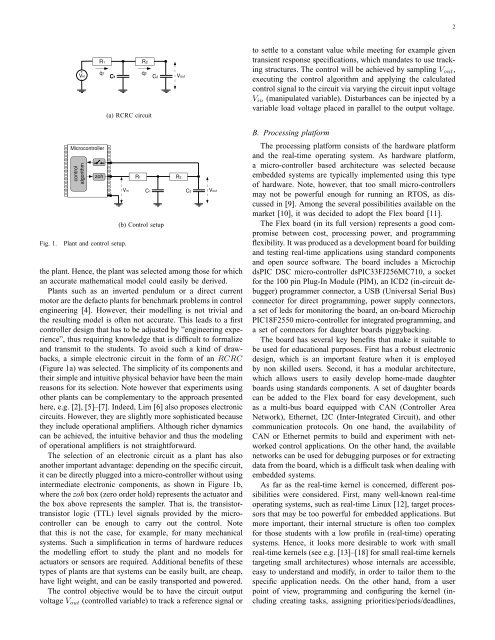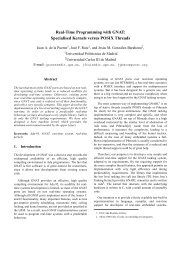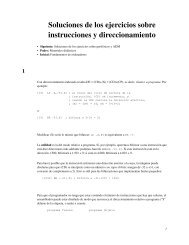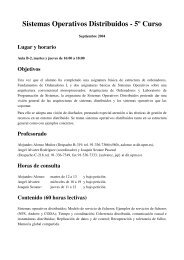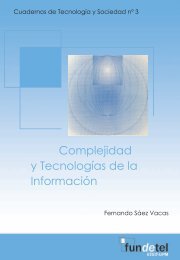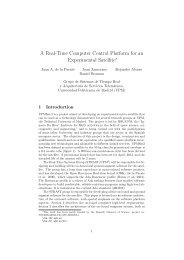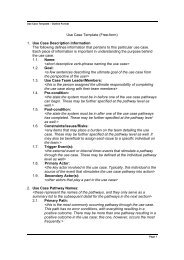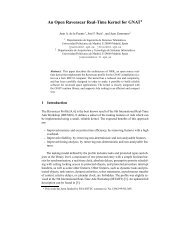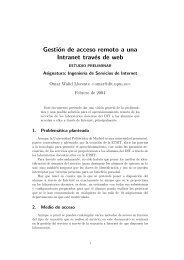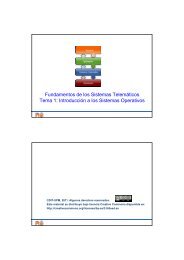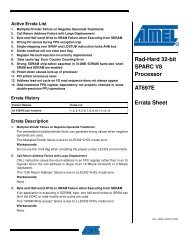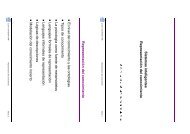Lab Proposal for Integrated Real-time and Control - DCS - UPC
Lab Proposal for Integrated Real-time and Control - DCS - UPC
Lab Proposal for Integrated Real-time and Control - DCS - UPC
Create successful ePaper yourself
Turn your PDF publications into a flip-book with our unique Google optimized e-Paper software.
2Fig. 1.Plant <strong>and</strong> control setup.(a) RCRC circuit(b) <strong>Control</strong> setupthe plant. Hence, the plant was selected among those <strong>for</strong> whichan accurate mathematical model could easily be derived.Plants such as an inverted pendulum or a direct currentmotor are the defacto plants <strong>for</strong> benchmark problems in controlengineering [4]. However, their modelling is not trivial <strong>and</strong>the resulting model is often not accurate. This leads to a firstcontroller design that has to be adjusted by ”engineering experience”,thus requiring knowledge that is difficult to <strong>for</strong>malize<strong>and</strong> transmit to the students. To avoid such a kind of drawbacks,a simple electronic circuit in the <strong>for</strong>m of an RCRC(Figure 1a) was selected. The simplicity of its components <strong>and</strong>their simple <strong>and</strong> intuitive physical behavior have been the mainreasons <strong>for</strong> its selection. Note however that experiments usingother plants can be complementary to the approach presentedhere, e.g. [2], [5]–[7]. Indeed, Lim [6] also proposes electroniccircuits. However, they are slightly more sophisticated becausethey include operational amplifiers. Although richer dynamicscan be achieved, the intuitive behavior <strong>and</strong> thus the modelingof operational amplifiers is not straight<strong>for</strong>ward.The selection of an electronic circuit as a plant has alsoanother important advantage: depending on the specific circuit,it can be directly plugged into a micro-controller without usingintermediate electronic components, as shown in Figure 1b,where the zoh box (zero order hold) represents the actuator <strong>and</strong>the box above represents the sampler. That is, the transistortransistorlogic (TTL) level signals provided by the microcontrollercan be enough to carry out the control. Notethat this is not the case, <strong>for</strong> example, <strong>for</strong> many mechanicalsystems. Such a simplification in terms of hardware reducesthe modelling ef<strong>for</strong>t to study the plant <strong>and</strong> no models <strong>for</strong>actuators or sensors are required. Additional benefits of thesetypes of plants are that systems can be easily built, are cheap,have light weight, <strong>and</strong> can be easily transported <strong>and</strong> powered.The control objective would be to have the circuit outputvoltage V out (controlled variable) to track a reference signal orto settle to a constant value while meeting <strong>for</strong> example giventransient response specifications, which m<strong>and</strong>ates to use trackingstructures. The control will be achieved by sampling V out ,executing the control algorithm <strong>and</strong> applying the calculatedcontrol signal to the circuit via varying the circuit input voltageV in (manipulated variable). Disturbances can be injected by avariable load voltage placed in parallel to the output voltage.B. Processing plat<strong>for</strong>mThe processing plat<strong>for</strong>m consists of the hardware plat<strong>for</strong>m<strong>and</strong> the real-<strong>time</strong> operating system. As hardware plat<strong>for</strong>m,a micro-controller based architecture was selected becauseembedded systems are typically implemented using this typeof hardware. Note, however, that too small micro-controllersmay not be powerful enough <strong>for</strong> running an RTOS, as discussedin [9]. Among the several possibilities available on themarket [10], it was decided to adopt the Flex board [11].The Flex board (in its full version) represents a good compromisebetween cost, processing power, <strong>and</strong> programmingflexibility. It was produced as a development board <strong>for</strong> building<strong>and</strong> testing real-<strong>time</strong> applications using st<strong>and</strong>ard components<strong>and</strong> open source software. The board includes a MicrochipdsPIC DSC micro-controller dsPIC33FJ256MC710, a socket<strong>for</strong> the 100 pin Plug-In Module (PIM), an ICD2 (in-circuit debugger)programmer connector, a USB (Universal Serial Bus)connector <strong>for</strong> direct programming, power supply connectors,a set of leds <strong>for</strong> monitoring the board, an on-board MicrochipPIC18F2550 micro-controller <strong>for</strong> integrated programming, <strong>and</strong>a set of connectors <strong>for</strong> daughter boards piggybacking.The board has several key benefits that make it suitable tobe used <strong>for</strong> educational purposes. First has a robust electronicdesign, which is an important feature when it is employedby non skilled users. Second, it has a modular architecture,which allows users to easily develop home-made daughterboards using st<strong>and</strong>ards components. A set of daughter boardscan be added to the Flex board <strong>for</strong> easy development, suchas a multi-bus board equipped with CAN (<strong>Control</strong>ler AreaNetwork), Ethernet, I2C (Inter-<strong>Integrated</strong> Circuit), <strong>and</strong> othercommunication protocols. On one h<strong>and</strong>, the availability ofCAN or Ethernet permits to build <strong>and</strong> experiment with networkedcontrol applications. On the other h<strong>and</strong>, the availablenetworks can be used <strong>for</strong> debugging purposes or <strong>for</strong> extractingdata from the board, which is a difficult task when dealing withembedded systems.As far as the real-<strong>time</strong> kernel is concerned, different possibilitieswere considered. First, many well-known real-<strong>time</strong>operating systems, such as real-<strong>time</strong> Linux [12], target processorsthat may be too powerful <strong>for</strong> embedded applications. Butmore important, their internal structure is often too complex<strong>for</strong> those students with a low profile in (real-<strong>time</strong>) operatingsystems. Hence, it looks more desirable to work with smallreal-<strong>time</strong> kernels (see e.g. [13]–[18] <strong>for</strong> small real-<strong>time</strong> kernelstargeting small architectures) whose internals are accessible,easy to underst<strong>and</strong> <strong>and</strong> modify, in order to tailor them to thespecific application needs. On the other h<strong>and</strong>, from a userpoint of view, programming <strong>and</strong> configuring the kernel (includingcreating tasks, assigning priorities/periods/deadlines,


